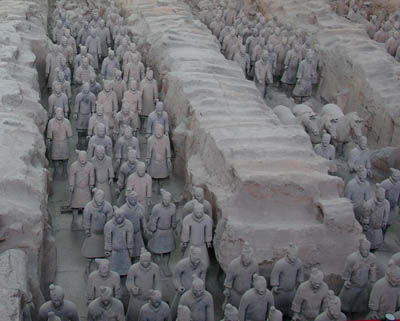The largest traveling exhibition of artifacts from the terracotta army -- and from the tomb of the emperor who wanted the clay warriors to help him rule in the afterlife -- left the ancient Chinese capital Xi'an for London on Thursday.
The 120 objects from the mausoleum of Emperor Qin Shihuang, who ruled from 221 to 207 BC, were being trucked to Beijing, from where they would be flown to London, said Wu Yongqi, curator of the Museum of the Terracotta Warriors and Horses of Qin Shihuang.
In London, a Terracotta Army exhibition has been scheduled at the British Museum from Sept. 13 to April 6, 2008.
"It's going to be the largest exhibition of the terracotta army ever to be seen outside China," said Zhao Kun, a specialist in charge of heritage preservation at the Chinese museum.
The exhibits will include 20 life-sized statues of warriors, acrobats and musicians, as well as weapons, copper and jade items.
"We hope the exhibition will help the British people learn something about China's military and art 2,200 years ago," said Wu.
The British Museum held its first-ever exhibition in China last year, displaying rare artifacts such as the Rosetta Stone from Egypt and paintings from European Renaissance masters.
The 2,200-year-old Chinese terracotta army buried around the mausoleum was one of the greatest archeological finds of modern times. It was discovered in Lintong County, 35 km east of Xi'an, in 1974 by peasants who were digging a well.
More than 1,000 life-size figures were found, representing the Emperor's army and including officers, horses, archers, and chariots. No two soldiers in the army are alike. Each of the sand-colored statues has a different facial expression and hairstyle, and craftsmen are believed to have modeled them after a real army.
The discovery, listed as a world heritage site by UNESCO since December 1987, has turned Xi'an, capital of the northwestern Shaanxi Province, into one of the nation's major tourist attractions.
A museum opened in 1979 which covers the original excavation site leaving the repaired soldiers in the place they were found. It has since received about 60 million visitors, including at least six million from abroad.
An exhibition of the terracotta army was staged in Edinburgh in 1985.
(Xinhua News Agency August 9, 2007)



